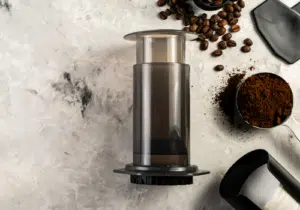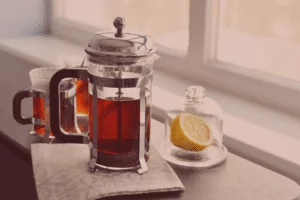How To Grind Coffee Beans In A Blender In 30 Seconds
Disclosure: This post contains affiliate links and I may earn a small commission (at no extra cost to you) if you click through and make a purchase. Thanks in advance – I really appreciate it!
Many of my friends who suddenly found themselves without a grinder or worse – a broken one, have asked me if using any home appliance with a rotating blade such as a blender is good enough to grind coffee beans. So I decided to write an article about it!
Key Takeaways:
So, how to grind coffee beans in a blender?
To grind coffee beans in a blender, start by adding a small amount (¼ cup) of beans and grinding them using a series of short (3 to 5 second) pulses. Using a blender produces a coarse coffee grind size which is perfectly suitable for drip, pour-over, French Press, and cold brewing.
If you want a step-by-step procedure of grinding coffee beans when all you have is a blender, then I highly recommend that you read this whole article because I will also give you some other alternative methods that you can use in case you’re not able to get a proper consistency with your blender.
How To Grind Coffee Beans With a Blender
If you like to grind your own coffee instead of purchasing coffee grinds from a store, you most likely have your own burr coffee grinder. But what happens if the grinder breaks or you find yourself in the middle of an unusual coffee setup with whole beans but no grinder.
Luckily for you, this detailed guide on how to grind coffee beans using a blender will give you step-by-step instructions on how to go about it. You can follow the below instructions whether you have a Vitamix, MagicBullet, NutriBullet, or a Ninja Blender.
- Start by using a small quantity of coffee beans, so measure out ¼ cup of beans.
- Pour the measured out coffee beans into your clean and dry blender and close the lid shut.
- Select the “medium-high” setting, or “grinder” setting if your blender has one.
- Use the pulse setting and grind coffee beans in very short pulses of not more than 3 to 5 seconds.
- Do not grind the beans for more than 30 seconds as the heat produced might alter the taste of your coffee.
- Repeat this method until you’ve got enough grinds to make a batch of coffee.
This will take some time if you’re planning to brew a whole pot for your friends, but going through this process slowly will ensure that you get a delicious brew of coffee without rendering your blender useless.
Why you should only use a small amount of coffee beans when grinding in a blender?
It’s important that you only use a small amount of beans in your blender. If you try to run your blender with too many coffee beans in it, you’ll end up with inconsistent grind size with chunks of broken coffee beans of all sizes.
Grinding the beans in small batches will ensure that your beans have ample room to move and grind up real nicely.
Also, working in small batches preserves the flavor of the beans because, the longer the blender runs, the more the temperature inside of the blender will rise.
Moreover, if the blades of your blender get stuck because of too many coffee beans, you could also cause irreversible damage not just to the blades but also to the motor of your blender. So don’t be tempted to rush this process or you won’t just end up with inconsistent coffee grinds but also with a broken blender.
Why you should grind coffee beans in short pulses when using a blender?
You should grind coffee beans intermittently in short pulses of 3-5 seconds in order to avoid the heat from the blender overheating and cooking the coffee beans. If you continuously blend the coffee beans, the oils from the beans may overheat, resulting in a loss of flavor.
It’s easy to burn the coffee with a blender due to the friction caused by the blades rotating at a very high speed. The longer you grind the beans without pausing, the more heat is created by the blades. This could give your coffee a burned and more bitter flavor. Basically, the pulsing action prevents heat from building up.
What coffee grind size does a blender produce?
Using a blender to grind coffee beans will produce a coarse grind size. Coffee bean grind consistency is critical to the flavor of the cup it produces. If there are any inconsistencies, the natural oils in the beans will be extracted improperly, resulting in a bitter flavor. The oils and flavors of the beans will be extracted with much greater accuracy with the correct, consistent grind, resulting in a smoother cup of coffee.
What are the types of coffee you can brew when grinding coffee beans in a blender?
As I already mentioned before, grinding coffee beans in a blender produces a coarse coffee grind size.
Coarse grind coffee can be used in brewing methods such as drip, pour-over, French Press, and cold-brew.
How to measure out the amount of coffee beans to grind in a blender?
As we discussed before, you should always start by using a small amount of coffee beans preferably ¼ cup in your grinder. You can use a kitchen scale or a coffee scale to measure the right amount.
Hario’s V60 drip scale (Amazon) is one of my favorite brewing tools. Its weighing platform accommodates the most popular brewers and servers, as well as portafilters for measuring espresso doses. A built-in timer is helpful for tracking brew time and its low resolution ensures maximum accuracy along the way. Pour-over brewing, immersion methods, will all be improved by adding Hario’s scale (Amazon) to your arsenal.
I love the size of the scale, and the fact that it charges fast via USB-C is a great feature.
Why should you grind coffee at home?
For the best flavor and aromas to be extracted into a delicious cup of coffee it’s imperative that you grind your coffee at home just before brewing it.
Coffee is quite aromatic and full of flavor when it is first ground. Even ten minutes after grinding, coffee begins to lose its flavor!
Grinding coffee beans reduces their surface area, which causes the beans to lose their flavor more rapidly than they would if they were left as whole beans.
When you grind coffee even moisture in the air can cause the flavorful, water-soluble parts of the coffee bean to dissolve. In addition, oxidation, which occurs naturally, is sped up once the surface area of the coffee bean is reduced through grinding.
Will coffee beans ruin a blender?
Coffee beans can ruin a blender if a large quantity of beans is put in it for grinding. The safest way to grind beans in a blender without causing any harm to its blades or motor is to use a small amount of beans (¼ cup) at one time and grind them in short pulses of 3-5 seconds.
What to do if my blender doesn’t have a pulse setting?
If your blender doesn’t have a pulse setting then grind the beans intermittently on “medium-high” speed in intervals of 3-5 seconds to avoid the heat from the blender overheating the oils in the beans.
What are the other methods to grind coffee beans without a grinder?
With the help of some kitchen tools, you can easily grind coffee beans even if you don’t have a grinder.
Food Processor
Similar to the blender, pour the desired amount of coffee into the food processor and make sure the lid is firmly in place.
Using the pulse setting, grind the beans in time limits of 3 to 5 seconds. Repeat the process until you have the required amount of grinds with proper consistency.
Mortar & Pestle
Pour the desired amount of coffee beans into the mortar, use the pestle and a little bit of elbow grease to crush the beans against the bottom of the mortar. Stir them up a bit as you go to ensure you get all the beans crushed. Continue the process until the grinds reach the consistency you want.
Rolling Pin
Put coffee beans into the plastic bag or between two sheets of parchment paper.
Lay the bag flat on the counter.
Using the pin like a hammer, press down to crush your beans. Continue to roll the pin back and forth over the grounds until they reach the consistency you prefer.
Hammer
Put beans in a high-quality plastic freezer bag, then put that package between towels. Then use a meat-tenderizing mallet or regular old hammer to crush the beans.

Amit Gupta
Hi, my name is Amit Gupta, and I am the owner and contributor at Cafeish. My obsession with coffee started when I received my first French press as a gift almost ten years ago. Since then, my love of coffee – and the number of coffee gadgets I own – has grown considerably.
Most Popular
ABOUT US
We are a team of coffee affcianados with experience and expertise in making world renowned coffee. In fact, preparing the best coffee ever with a fluffy top reminds us of magic, with secrets of how to achieve each particular effect. Making coffee is not our only hobby, we always keep our ears open as to what’s happening around and what scientists and manufacturers produce for consumers. It’s not an easy task to do – it’s rather time consuming. Hence, Caféish website was launched.
LEGAL DISCLAIMER
Caféish is a participant in the Amazon Services LLC Associates Program, an affiliate advertising program designed to provide a means for sites to earn advertising fees by advertising and linking to Amazon.com. Caféish also participates in affiliate programs with Clickbank and other sites. Caféish is compensated for referring traffic and business to these companies.




